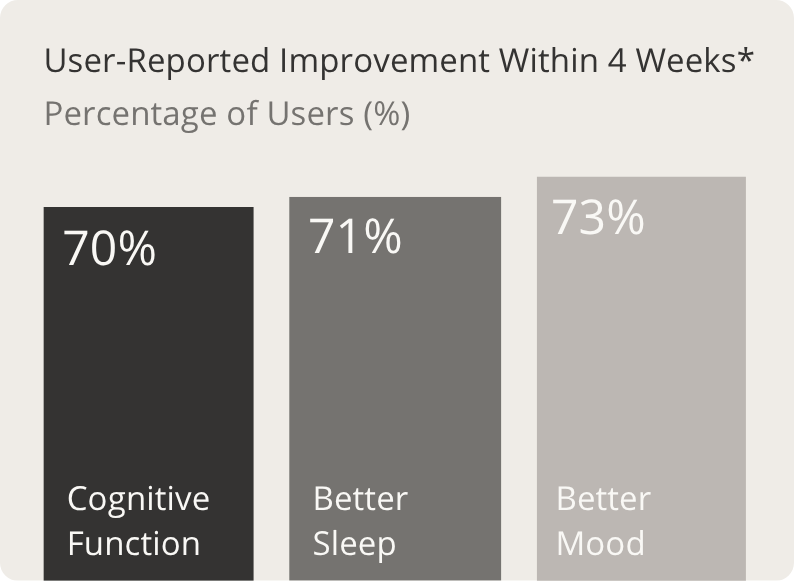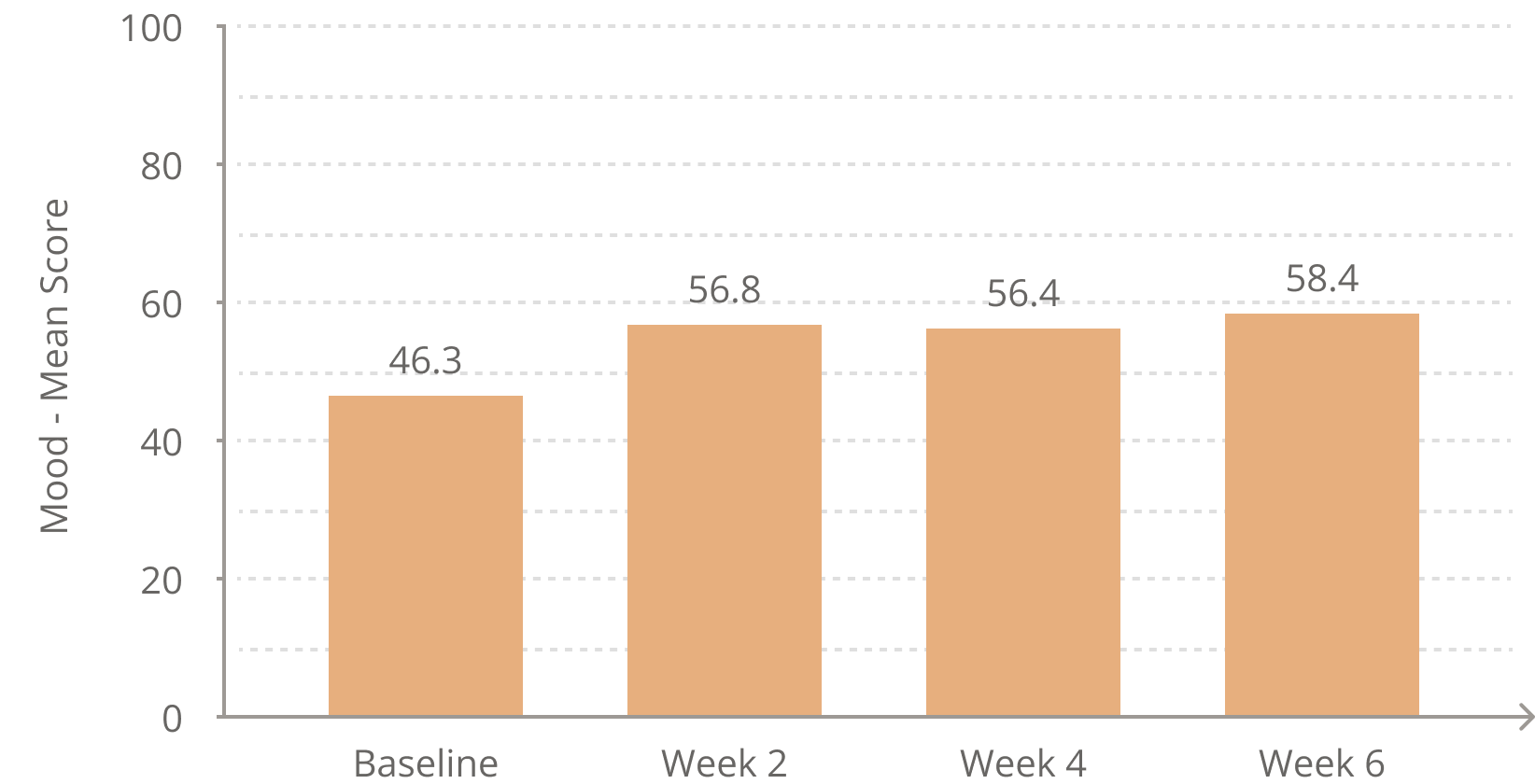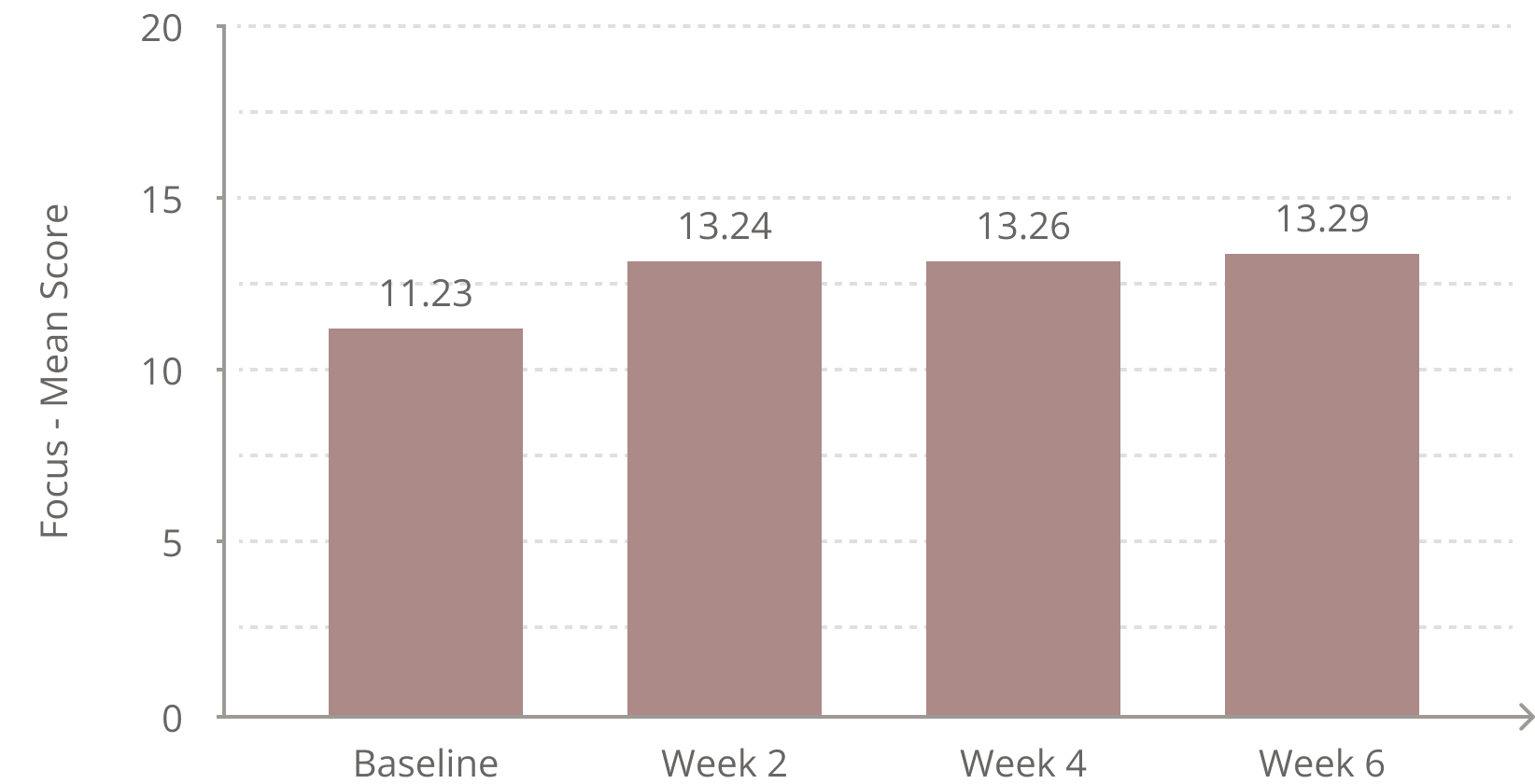Halo Evidence
What our real world data shows
An analysis was conducted in October 2025 on data collected through the Halo app as part of a prospective, longitudinal real-world study.
In 103 adult users who completed four validated assessments (baseline, week 2, 4 and 6), significant improvements were observed across mood, sleep, and focus by week 2 - sustained through week 6.
All outcomes were measured using standardized patient-reported outcome (PRO) instruments and reached p < .0001 across domains.
70% Improved by Week 4
- 73% reported better mood
- 71% slept better and felt more rested
- 70% experienced sharper focus and mental clarity
- Most users noticed results within the first two weeks

Results by Domain

Mood (WHO-5)
- Mean improved from 46.25 → 56.78 (W2) → 58.41 (W6)
- 72.8% improved by Week 2; 69.9% by Week 6
- Effect size grew from 0.60 → 0.77
Mood (WHO-5)
- Mean improved from 46.25 → 56.78 (W2) → 58.41 (W6)
- 72.8% improved by Week 2; 69.9% by Week 6
- Effect size grew from 0.60 → 0.77

Sleep (PROMIS Sleep Disturbance, reversed)
- Mean improved from 12.25 → 13.85 (W2) → 13.88 (W4) → 13.66 (W6)
- 63.1% improved by Week 2; 69.9% by Week 4
- Effect size: 0.59 → 0.70
.png?width=1644&height=840&name=Group%2017555%20(2).png)
Focus (PROMIS Cognitive Function)
- Mean T-score: 42.83 → 46.9 → 46.8
- 63–71% improved across timepoints
- Effect size: 0.49–0.68


Focus (PROMIS Cognitive Function)
- Mean T-score: 42.83 → 46.9 → 46.8
- 63–71% improved across timepoints
- Effect size: 0.49–0.68
Who Was Included
This real-world analysis included 103 adult Halo users (≥18 years) who completed all four validated self-report assessments - at baseline, week 2, week 4, and week 6.
Participants were regular Halo app users who had engaged in consistent use of the headset and submitted their patient-reported outcomes (PROs) through the in-app questionnaire system.
Sample size (N): 103
Age: Adults aged 18 to 70 years, with a mean age of approximately 38 years (estimated SD ≈ 12 years).
Gender: Approximately balanced distribution is expected (final male:female ratio pending additional analysis).
Data source: Anonymized, app-linked PRO dataset collected prospectively from Halo users in 2025.
Methods
Design: Real-world longitudinal analysis of Halo users completing WHO-5, PROMIS Sleep, and PROMIS Focus assessments.
Statistics: Paired t-tests vs baseline; p < .0001 across all domains/timepoints.
Effect size: Cohen’s dz reported for each comparison.
Interpretation: Higher scores = better well-being, sleep, and cognitive function.
Real-world analysis of Halo users (≥18 years) who completed all 4 follow-ups (N=103).
All analyses by Flow Neuroscience medical statistics team, 2025. p < .0001 across domains.
About the Questionnaires
Halo’s real-world analysis is based on data from adults aged 18 and over who used the Halo device regularly and completed three validated Health-Related Quality of Life (HRQL) questionnaires at baseline and at weeks 2, 4, and 6. These measures capture self-reported changes in mood, sleep, and focus over time.
WHO-5 Well-Being Index (Mood)
The WHO-5 is a widely used measure of psychological well-being. It includes five positively worded statements assessing mood, motivation, and energy over the past two weeks.
- Score range: 0–100
- Higher scores indicate better well-being
- Interpretation:
- 50 = Good well-being
- 29–50 = Mildly reduced well-being
- ≤ 28 = Indicative of poor well-being
Changes in WHO-5 scores reflect shifts in overall mood and emotional balance. In Halo’s data, average scores increased steadily across six weeks, with most users moving into the “good well-being” range by week 6.
PROMIS Sleep Disturbance (Reversed)
The PROMIS Sleep Disturbance questionnaire evaluates perceived sleep quality, refreshment, and restfulness. For clarity of interpretation, scores in Halo’s analysis were reversed, meaning higher values correspond to better sleep quality.
- Score range: 4–20
- Higher scores indicate better sleep
- Interpretation:
- 12–20 = Green – Sleeping well and waking rested
- 9–11 = Amber – Sleep could be more refreshing
- 5–8 = Amber – Sleep quality affecting daytime function
- 4 = Red – Very disrupted sleep
Mean sleep scores improved most notably by week 4, indicating better perceived sleep quality for the majority of users.
PROMIS Cognitive Function – Abilities (Focus)
The PROMIS Cognitive Function scale measures self-perceived concentration, mental clarity, and the ability to sustain attention.
- Score range: 4–20
- Higher scores indicate stronger focus and mental performance
- Interpretation:
- 13–20 = Green – Healthy focus and concentration
- 10–12 = Amber – Mild lapses in focus
- 4–9 = Red – Lower-than-usual focus
Focus scores improved consistently throughout the 6-week period, with many users moving from the amber to green range after two weeks of use.
Data Interpretation
Results were derived using paired t-tests comparing each follow-up timepoint (weeks 2, 4, 6) with baseline. Changes are presented as mean improvements and percent change for each measure, alongside effect sizes to quantify the magnitude of improvement. Together, these metrics provide a clinically meaningful view of how regular Halo use supports well-being, sleep quality, and focus in healthy adults.
“Halo has made a clear difference - improving my mood, energy, and sleep in just six weeks.”
.png?width=2000&height=1500&name=Untitled%20design%20(96).png)
Scott Forman, MD, MSc
Try Halo with a 30-day money-back guarantee
Anyone can get a refund within 30 days. We’ve made our returns process as straightforward as possible.
Submit your refund request within 30 days of the shipment date.
Receive a prepaid return shipping label via email.
Drop off the parcel at any certified mail location or schedule a collection.